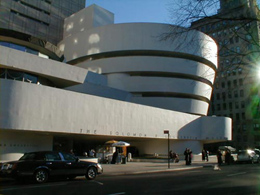
The Guggenheim Museum boasts modernity, and the building is equally inviting
 |
The modern circular building, with ribbon windows resembling a hatbox or flying saucer, is located at a "good address" at the edge of Central Park. The dominant feature of the museum is a massive concrete spiral, giving the building its distinctive shape. Inside, this spiral serves as a ramp for walking and displays paintings on its walls. Natural light floods the space through a glass ceiling, shaped in a star pattern made up of 13 separate pieces. Initially, the building faced significant resistance from New Yorkers—some found it provocative, while others deemed it dull.
The Guggenheim Museum was originally focused on the development of non-figurative art but gradually became a gallery of modern art spanning from Impressionism and Post-Impressionism to the latest artistic trends. Retrospective exhibitions featuring Paul Klee (1967) and Piet Mondrian (1971) garnered great acclaim, as did explorations of certain nonconformist figures, such as the German provocateur Joseph Beuys. The museum continues to acquire paintings and entire collections, adding a valuable set of minimalist art in 1991.
The history of the collection reportedly began with a wager. Guggenheim (1861 to 1949), a well-known industrialist and one of the wealthiest men of his time, participated in a social dinner in 1928 and, on a whim, bet his neighbor that she could not paint his portrait. That neighbor was the then 38-year-old baroness and painter Hilla von Rebay, who studied art and sympathized with the Dadaists and artists around the Bauhaus art school. In the wager, Rebay sensed an opportunity to gain an influential patron for her support of modern art.
Her eloquence and charm succeeded, and shortly after their initial meeting, Guggenheim purchased his first abstract paintings. The baroness introduced him to leading artists and eventually became the driving force behind the growing collection. In 1937, the patron founded his own foundation, providing a solid legal basis for his future collection. Two years later, the first Guggenheim Museum of Abstract Art opened in a former New York car dealership. In 1948, the foundation took over the entire estate of the art dealer Karl Nierendorf.
An expert of Czech origin, refugee from the Nazis Thomas Messer, significantly shaped the operation of the gallery. In 1961, he took over leadership of the institution for a lengthy 27 years, guiding it into the elite. One of his savvy moves included securing the collection of Justin Thannhauser, featuring masterpieces of Impressionism, Post-Impressionism, and the early Paris School (including 34 works by Pablo Picasso). Messer did not forget about his countrymen; he purchased the first painting by František Kupka for the museum and introduced the works of Stanislav Kolíbal and Jiří Kolář.
The foundation also owns other branches. The opening of the museum in Bilbao, Spain, received considerable acclaim, partly due to the extravagant building designed by Frank Gehry (co-creator of Prague's Dancing House), which has become a tourist magnet. Guggenheim's niece Peggy (daughter of his brother Benjamin, who perished in the Titanic disaster) exhibited her collection in one of the Venetian palaces. In Berlin, the cultural center Deutsche Guggenheim operates, and a branch is set to open in Abu Dhabi in the United Arab Emirates in 2013.
The English translation is powered by AI tool. Switch to Czech to view the original text source.











